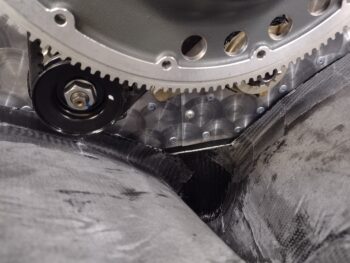Ahh, tis the season! The stormy season…
While last year a tropical storm moved up the east coast as Marco and I were ready to return from Rough River (thus an extra night at Mike Beasley’s to let the storm pass through), this year a storm hit pre-RR. Again, nothing major except a lot of wind and rain. More rain this time than wind.
So, it may not be surprising that I report that over half of my shop has a soggy floor, going on a couple days now. And as such, I’ve been focused on some tech refreshes (both personal and airplane) and checking out/developing my action camera mounting & use plan for the Long-EZ.
Pre-storm I did pull the peel ply from the bottom cowl aft baffle rib outrigger layups, and then marked and trimmed the newly made baffle ribs //slash// bottom cowl stiffener.
Here we have a couple of shots of the final-configured bottom cowl aft baffle ribs and stiffener with the bottom cowl installed.
Although my shop is still drying out, I was done being sidelined and pressed forward with a task that may not be critical in the initial airworthiness of this airplane, but one that’s been gnawing at me and that I wanted complete. And that is correcting the looseness of the fit between the prop spinner and flow guide’s (“lampshade”) mounting flange that the spinner attaches to.
Many months ago I confirmed that my spinner was woefully lacking the correct number of plies when I was discussing with Dave Berenholtz cutting the spinner to mount over and around the prop blades. He noted that he filled in the resulting notches just forward of the prop blades with carbon fiber plates he laid up using 10 plies of CF. 10 plies?!? I asked. Why when the spinner is only 3 plies thick? Well, apparently his Catto spinner is 10 plies at the mounting interface, while again mine is only 3 (as guesstimated with my micrometer measurements).
Since I needed to sand the inside edge to add 6 plies of carbon fiber inside the mounting interface (I’ll add more if and as required), I also wanted to get rid of some of “gob-a-goos” that were for some reason included with my Catto prop spinner. Here is the first blob (pic 1) and then removed with the Dremel tool and sandpaper (pic 2).
And the same thing on gobagoo #2. Thankfully that was all that remained from Catto’s build process.
With 6 plies of CF getting laid up, I stepped them with the first 2 plies going in being 1.5″ in width (or deep, maybe). The second pair of plies going in were 1.25″ wide, while the last pair was 1″ wide. The constant reference point was the opening edge of the spinner.
I used the high temp epoxy HTR-212 I have on hand, and peel plied the layup. I then set it aside to cure overnight.
My next task was also something I’ve been pondering over the last week. I removed the engine starter and alternator cables and remounted them in a couple more configurations than I originally had them (with starter cable on top) before settling on this configuration below, which provides the best clearance between all cables, engine components and that ubiquitous fuel line.
To ensure the starter cable wouldn’t get gnawed through over time from the bottom cowling, I covered the cable with 2 pieces of cardboard zip-tied in place to act as a sleeve, to give me about 1/4″ thickness as reference.
I then mounted the bottom cowling and put my phone up into the right armpit air intake scoop and grabbed a few blind pics. It may be hard to tell in this pic, but if I blow it up on my phone I can see definite good daylight between the inside bottom cowling and the padded starter cable.
I confirmed the gap by shoving my phone into the gap just near the #2 cylinder bottom spark plug to get this shot, also showing good clearance with my now settled starter and alternator cable runs/configuration.
And with all these build shenanigans under my belt, I called it a night.
Yep, pressing forward… ever so slowly!



































































